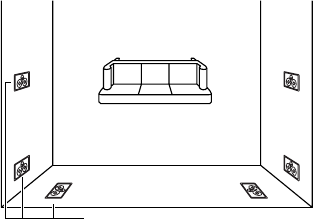
6
If two surrounds are used in a standard 5.1 configuration (not 7.1 or EX), they are best mounted
to the sides of the listening area. This means straight to the sides of the listener or in line with
the primary row of seating, plus or minus 15 degrees. This is preferred over back wall mounting
for several reasons: It places the surrounds at locations where the difference between left ear
and right ear discrimination is at a maximum. This gives the maximum sense of “envelopment”
or being surrounded by sound. Rear
mounted speakers force a huge angular
gulf between the front primary speakers
and the rear speakers. The sound image
is inherently discontinuous. Also, front
to rear aural discrimination is not very
strong. Differentiation between front
and rear speakers will not be as strong
as the effect of adding speakers to the
side. 7.1 or EX systems that use side and
rear speakers together overcome all of
these obstacles and give both maximum
envelopment and a more continuous
surround effect.
A second factor to consider is the evenness of sound coverage over the seating area. Most
surround processors have features for setting the balance of all channels. A circulating noise
signal is adjusted in each channel until the apparent or measured sound level is even. Of course,
moving to another seat will shift this balance somewhat. Well-placed surround speakers will
minimize the level variation from seat to seat. The best way to achieve evenness is to increase
the distance of the surround speakers from the listening area. Mount them high on the side
walls or even on the ceiling. As a good rule of thumb, surrounds should be on the side walls at
least one foot above the height of a standing listener. If the speakers are ceiling-mounted, they
should be close to the side walls, well away from an overhead position.
If a large theater room with three or more rows of seats is planned, then more than one pair of
surround speakers should be used to give more even coverage and a more diffuse sound field.
We recommend that a pair of surrounds be used for every other seating row (the first, the third,
the fifth, etc.). This follows standard cinema practice.
Special Considerations for the AMC 900
THX
Placement of a dipole surround speaker, such as the AMC 900
THX
, requires another consider-
ation. For a dipole to give a properly diffuse sound the listeners should be on or near the “null
plane”. Imagine a line running down the middle of the front of the AMC 900
THX
(along the
longer dimension), between the two tweeters and across the center of the woofer. A plane
sticking straight out from this line (at 90 degrees to the wall) defines the null plane. For any
listener on this plane, the output of the two tweeters and the midrange will be at maximum
cancellation. A listener at this position will hear the speaker only via multiple wall reflections.
This is why the dipole sounds diffuse.
So the AMC 900
THX
should be installed where the null plane will run through the primary
listening area. This can be achieved either with the AMC 900
THX
installed in a side wall (with the
long axis of the speaker oriented vertically) or on the ceiling (with the long axis of the speaker
oriented across the width of the room).
Optional Direct Radiation
Surround Speaker Locations














